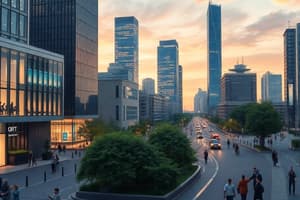Podcast
Questions and Answers
What is the primary goal of safeguarding against manipulation from outside?
What is the primary goal of safeguarding against manipulation from outside?
- To improve accountability of system users
- To ensure confidentiality of sensitive data
- To prevent unauthorized access to sensitive data (correct)
- To enhance the security of urban transit infrastructure
What is the primary purpose of using firewalls in data security?
What is the primary purpose of using firewalls in data security?
- To record user logs for accountability
- To improve the efficiency of public services
- To prevent unauthorized access to sensitive data (correct)
- To anonymize sensitive data
What is the primary function of user logs in data security?
What is the primary function of user logs in data security?
- To analyze road imagery for infrastructure development
- To anonymize sensitive data
- To record user interactions for accountability (correct)
- To prevent unauthorized access to sensitive data
What is the primary benefit of using autonomous traffic management platforms?
What is the primary benefit of using autonomous traffic management platforms?
What is the primary purpose of using artificial intelligence in RoadBotics' technology?
What is the primary purpose of using artificial intelligence in RoadBotics' technology?
What is the primary benefit of using automated buses in smart cities?
What is the primary benefit of using automated buses in smart cities?
What is the primary role of Hayden AI in smart city development?
What is the primary role of Hayden AI in smart city development?
What is the primary goal of using AI-powered technologies in smart cities?
What is the primary goal of using AI-powered technologies in smart cities?
What is the primary benefit of using AI-powered waste management systems?
What is the primary benefit of using AI-powered waste management systems?
What is the primary role of AI in pollution control in smart cities?
What is the primary role of AI in pollution control in smart cities?
Flashcards are hidden until you start studying
Study Notes
AI in Smart Cities
- Smart cities use AI to detect people from their clothes, allowing for quicker suspect identification.
- AI helps cities monitor and control pollution levels, enabling informed decisions for the environment.
- Real-Time Response Centres (RTRC) analyze data from various sources, including cameras, traffic sensors, and gunshot detectors.
Face Detection and Identity Verification
- AI-powered face recognition technology detects and identifies people, verifying their identities.
- Security cameras and drones use AI to recognize and match faces with database records.
AI in Pollution Control
- AI analyzes current pollutants and predicts pollution levels for the next 2 hours, enabling proactive decisions.
- Authorities use AI to make informed decisions to reduce environmental impact.
Dynamic Pricing in Smart Cities
- AI-based dynamic pricing for parking lots adjusts prices in real-time based on peak/non-peak times and other factors.
- The system analyzes parking occupancy, availability, and frequency of use to predict consumer demand.
AI in Waste Management
- Smart cities use AI to track recycling and identify recyclable materials.
- AI-powered robots sort rubbish and clean areas like lakes and rivers.
- AI-enabled cameras detect and categorize trash on the streets.
AI in Environmental Development
- Smart cities use AI to monitor local environmental impact, global warming, and pollution levels.
- AI helps cities make informed decisions to reduce environmental impact.
AI in Smart Homes
- AI connects and integrates multiple IoT devices, learning human behavior and preferences.
- AI-powered smart home devices interact and acquire new data to predict user behavior.
- AI automates smart home devices according to user preferences.
AI in Transportation
- AI and computer vision transform urban transit infrastructure, improving public services.
- Autonomous traffic management platforms automate complex processes.
- AI-enabled buses reduce emissions, improve routes, and increase frequency.
- AI analyzes road imagery to identify issues and provide cost-effective solutions.
Studying That Suits You
Use AI to generate personalized quizzes and flashcards to suit your learning preferences.




